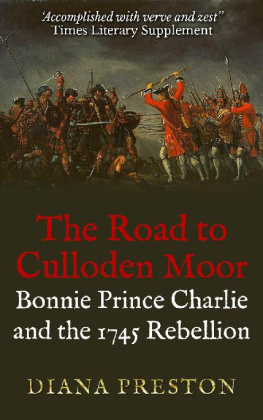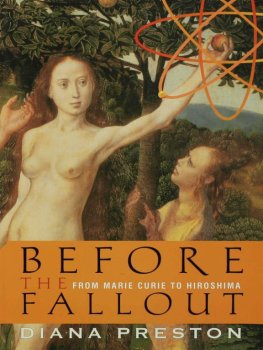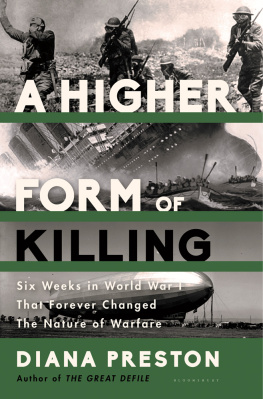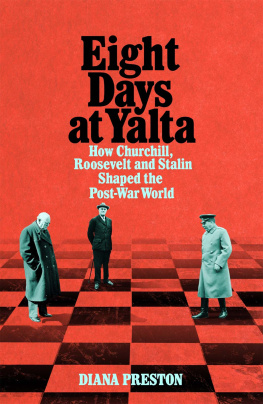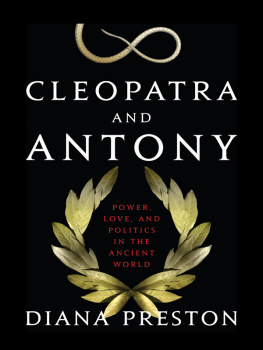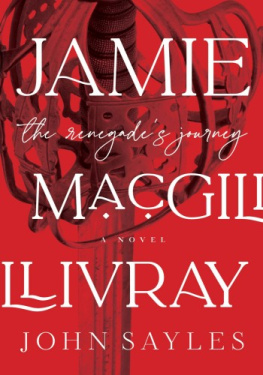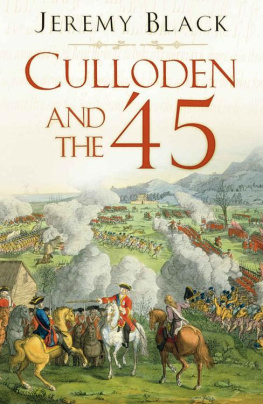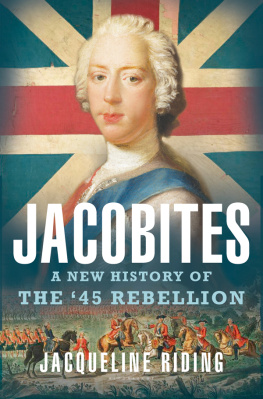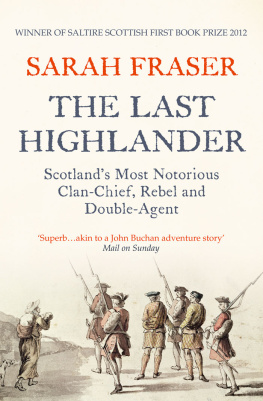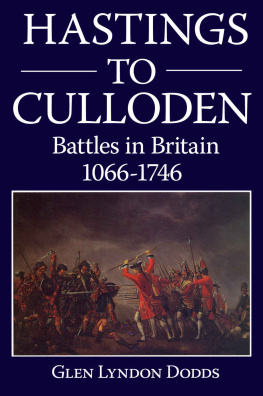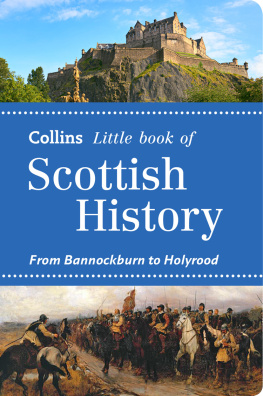Diana Preston - The road to Culloden Moor: Bonnie Prince Charlie and the 45 rebellion
Here you can read online Diana Preston - The road to Culloden Moor: Bonnie Prince Charlie and the 45 rebellion full text of the book (entire story) in english for free. Download pdf and epub, get meaning, cover and reviews about this ebook. year: 2014, publisher: Endeavour Media, genre: Art. Description of the work, (preface) as well as reviews are available. Best literature library LitArk.com created for fans of good reading and offers a wide selection of genres:
Romance novel
Science fiction
Adventure
Detective
Science
History
Home and family
Prose
Art
Politics
Computer
Non-fiction
Religion
Business
Children
Humor
Choose a favorite category and find really read worthwhile books. Enjoy immersion in the world of imagination, feel the emotions of the characters or learn something new for yourself, make an fascinating discovery.
- Book:The road to Culloden Moor: Bonnie Prince Charlie and the 45 rebellion
- Author:
- Publisher:Endeavour Media
- Genre:
- Year:2014
- Rating:4 / 5
- Favourites:Add to favourites
- Your mark:
- 80
- 1
- 2
- 3
- 4
- 5
The road to Culloden Moor: Bonnie Prince Charlie and the 45 rebellion: summary, description and annotation
We offer to read an annotation, description, summary or preface (depends on what the author of the book "The road to Culloden Moor: Bonnie Prince Charlie and the 45 rebellion" wrote himself). If you haven't found the necessary information about the book — write in the comments, we will try to find it.
The road to Culloden Moor: Bonnie Prince Charlie and the 45 rebellion — read online for free the complete book (whole text) full work
Below is the text of the book, divided by pages. System saving the place of the last page read, allows you to conveniently read the book "The road to Culloden Moor: Bonnie Prince Charlie and the 45 rebellion" online for free, without having to search again every time where you left off. Put a bookmark, and you can go to the page where you finished reading at any time.
Font size:
Interval:
Bookmark:
THE ROAD TO CULLODEN MOOR
Bonnie Prince Charlie and the 45 Rebellion
DIANA PRESTON
Diana Preston 1995
Diana Preston has asserted her rights under the Copyright, Design and Patents Act, 1988, to be identified as the author of this work.
First published 1995 by Constable and Company Limited.
This edition published in 2014 by Endeavour Press Ltd.
This edition published in 2018 by Endeavour Media Ltd.
Table of Contents
To Michael
ACKNOWLEDGEMENTS
I have always been fascinated by the legend of Bonnie Prince Charlie, not least because of a family connection with the events of the 45. Antoine Walsh, the Anglo-French slave trader who supplied the Prince with the vessel that took him to Scotland and sailed with him, is an ancestor of mine. As a child I came across a collection of Walshs correspondence with the Prince and with a network of Jacobite agents. The letters defined a strange world of spies and intrigue, ambitious schemes and elaborate plots, but also a world of disillusionment and heartbreak. From those pages I could trace the high hopes of Charles and his supporters in 1744 and 1745 through the bitter aftermath of Culloden to the Princes decline and the end of the Jacobite dream. For me the story has an enduring mystique and I hope others find it as compelling.
It is difficult to know where to begin in thanking all the people who have helped me with this book. However, top of the list must be my husband Michael for his help with the research, his encouragement and for stopping me falling too much a victim to the spell of Bonnie Prince Charlie. I must also thank Vera Faith, Clinton Leeks, Neil Munro, Justina Binks and my agent Michael Thomas for their help and advice at various stages in the project. I would also like to thank the staff of the London Library for their efficiency and resourcefulness in locating the main source material.
Diana Preston
NOTE ON DATES:
Sometime before the 45, the continent of Europe adopted the new style Gregorian calendar, whereas Britain used the old style eleven days behind until 1752. All the dates in the book are given in the old style except for events on the Continent which, unless indicated otherwise, are new style. A good example is that in Rome Charless birthday takes place on New Years Eve 1720 (new style), but he celebrates his twenty-fifth birthday on 20 December 1745 (old style) as he retreats across the Esk back into Scotland from England.
NOTE ON QUOTATIONS:
On the few occasions where the eighteenth-century spelling and punctuation would, in my view, distract from the meaning or be confusing I have modernised them.
INTRODUCTION
Unless you tear our hearts out and rip our breasts right open, you will
never remove Charlie from us until we are snuffed out. He is woven into
our souls
In Rome, in early 1788, an old man lay dying in the arms of his illegitimate daughter. There was nothing heroic about his bloated body and protuberant blood-shot eyes, nothing to suggest that here lay one of the most charismatic and compelling figures in British history Bonnie Prince Charlie. To himself and to others he was a failure. His great ambition, to reclaim the throne of Britain for the Stuarts, had eluded him and the rest of his life had been an embarrassing descent into wife-beating, paranoia, despair and drunkenness. In those final moments his clouded mind may have recaptured his glory days during the 1745 Jacobite Rebellion. Perhaps, before his eyes dimmed forever, he saw himself young and handsome again, his body formed for war, as he marched at the head of his brave Highlanders. Perhaps he wondered how these events would be remembered, or if they would be remembered at all.
In fact the story of Bonnie Prince Charlie and the 45 is one of the most enduring. Two and a half centuries later the handsome young hero still gazes at us from the labels of thousands of liqueur and whisky bottles and tins of shortbread. This book tells that story and in so doing seeks to explain the legend and why it has such a special place in our folklore. How did a half-Polish prince, born in Rome, who spoke English with a foreign accent, and whose great undertaking ended in utter failure, become the celebrated Bonnie Prince Charlie of the poems and songs? Why does the 1745 Jacobite Rebellion still rouse such passionate emotions, particularly north of the border?
The answer lies partly in the story itself which has all the elements of high adventure. Even at the time people acknowledged that it was extraordinary. One of Charless officers described the 45 as one of the most memorable events that has distinguished the times we live in. Everybody knows that this Prince, with a handful of undisciplined men, made himself master of Scotland; penetrated into the heart of England; vanquished armies of regular troops in pitched battles; and for several months engaged the attention and kept in suspense the fate not of Great Britain only, but of Europe.
The story has two phases, each important in the creation of the legend. The first saw a series of dazzling successes, as Charles carried all before him and got within striking distance of London, causing a run on the Bank of England and panic among the capitals citizens. Yet it culminated in the disaster of Culloden, the last battle on British soil. It was the Princes only defeat and his cousin the Duke of Cumberlands only victory, but its impact was devastating, shattering the Jacobite dream and ending the Highland way of life. Culloden soon came to symbolize an heroic but doomed cause.
However, it is the second phase of the story which cemented Charles himself so firmly into our collective memory, his escape after Culloden and flight through the Highlands and islands have a powerful romantic appeal. It was full of hairbreadth escapes, drama and self-sacrifice. The stories of the faithful Highlanders including Flora Macdonald saving him at great risk to themselves and their families have become part of the folklore.
So the story of the 45 is truly the stuff of theatre and legends. It comes complete with heroes and villains. Bonnie Prince Charlie converts into the perfect hero, brave, handsome and chivalrous. Butcher Cumberland makes an appropriately villainous foil, corpulent as Charles is slender, harsh as Charles is merciful, a libertine in contrast with Charless virginal aloofness. Both transcend the centuries, larger than in life and one-dimensional, like characters from a melodrama. Others share the stage like gentle Lochiel, the Cameron chieftain, and Hangman Hawley, the suitably hissable Hanoverian general with a predilection for the gallows. There are spies and secret agents, heroes and heroines particularly Flora Macdonald and the beautiful and martial Lady Mackintosh to add the necessary romantic dimension. There is buried treasure and brave deeds. The sheer magnetism of the story has been celebrated over the years by a mass of songs and poems and novels. The works of Robert Burns, Sir Walter Scott and Robert Louis Stevenson all helped to nurture it.
What initially fed the legend was the use of what we might now recognise as public relations techniques. Both sides Hanoverian and Jacobite understood the value of influencing public opinion, and Charles was particularly adept at it. From an early age he showed an ability to create the right image and mould audiences, individuals and groups to his will. When Charles arrived in the Highlands in 1745 he consciously used his good looks and charm to appeal on an emotional level, presenting himself as the saviour who had come to throw off the Hanoverian yoke from the shoulders of his oppressed people. He dressed in Highland clothes to show that he identified with the clansmen. He marched at their head and shared their hardships to show he was as tough as them. His tactics were so successful that he became their Tearlach or Charlie. It was they who gave him the epithet Bonnie and called the period of the 45 Charlies Year.
Next pageFont size:
Interval:
Bookmark:
Similar books «The road to Culloden Moor: Bonnie Prince Charlie and the 45 rebellion»
Look at similar books to The road to Culloden Moor: Bonnie Prince Charlie and the 45 rebellion. We have selected literature similar in name and meaning in the hope of providing readers with more options to find new, interesting, not yet read works.
Discussion, reviews of the book The road to Culloden Moor: Bonnie Prince Charlie and the 45 rebellion and just readers' own opinions. Leave your comments, write what you think about the work, its meaning or the main characters. Specify what exactly you liked and what you didn't like, and why you think so.

